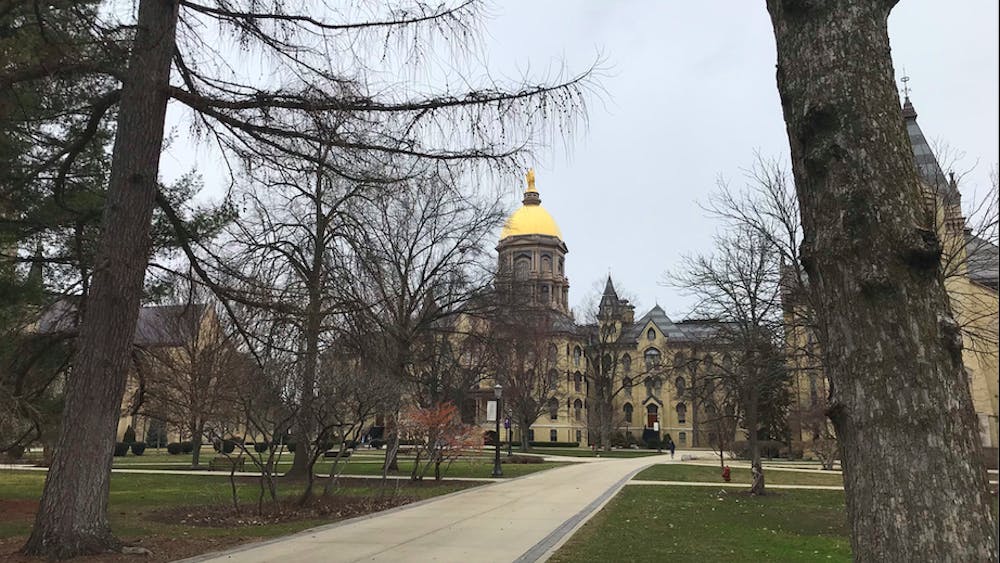Much as it was over a century ago, upward mobility for immigrants is often not achieved until the next generation, according to research and a new book by Leah Boustan, a Princeton economics professor who spoke at Notre Dame on Tuesday.
“This is the story of Ellis Island,” Boustan said. “It’s not a story of rags to riches. It’s a story of the first generation very, very slowly moving up, if at all, and children achieving upward mobility. And that is the story of immigration today as well.”
Her talk in Jenkins Nanovic Hall was part of the Combs Lecture Series. Boustan is the director of Princeton University’s “Industrial Relations Section” and a former research associate with the National Bureau of Economic Research. She also codirected the Development of the American Economy Program at the bureau.
“Professor Boustan’s work lies at the intersection of economic history and labor economics,” Notre Dame economics professor Eric Sims said. “We are very fortunate to have her discussing work from her most recent book, ‘Streets of Gold: America’s Untold Story of Immigrant Success.‘”
Boustan’s research is about the ability of children of U.S. immigrants to achieve upward mobility. Her book, cowritten with Stanford economist Ran Abramitzky, compares the economic mobility of immigrants in the early 20th century to the mobility of immigrants today.
“Ran and I decided to write this book because we feel like the national conversation about immigration policy has been driven by emotions and anecdotes and fears — rather than by data and evidence,” Boustan said. “The book is organized around reassessing and oftentimes busting some of these myths that we share about immigration.”
Boustan spoke about the “nostalgic view” that Americans have of immigrants who came to the United States a century ago and the misperception concerning the ease with which they moved up the economic ladder. She cited a quote on a wall at the Ellis Island National Museum of Immigration attributed to an unnamed Italian immigrant.
“I came to America because I heard the streets were paved with gold,” the immigrant said. “When I got here, I found out three things: First, the streets were not paved with gold. Second, they weren’t paved at all. Third, I was expected to pave them.”
Boustan said she searched through census records and data from ancestry.com to learn patterns about the economic mobility of immigrants and their children. She found that census data from her own family demonstrated a common path of economic mobility among immigrant families.
Boustan’s great grandfather immigrated to the States in 1891 and never moved up the economic ladder. The next generation did move up. Boustan’s grandfather, the second-youngest in the family, made it into the “professions.”
Boustan also said that the idea that America is in the midst of an unprecedented flood of immigration is a myth.
She said there is an “immigration valley” between 1920 and today that is the result of a set of immigration quotas that were imposed in 1921. In 1965, there was a limited reopening of the border, she added. The idea of “undocumented” immigration is relatively new, according to Boustan, because immigration is still restricted by quotas. Still, most immigrants are in the U.S. legally. About a quarter of immigrants are undocumented, according to the Pew Research Center.
Boustan also set out to bust the myth that immigrant families and their children are permanently stuck in the lower class today.
In a series of charts using data from the Internal Revenue Service, Boustan showed the economic mobility of children of households in the 25th percentile of the income distribution. On average, the children of white, U.S.-born parents in the 25th percentile moved to the 46th percentile. Children of immigrants born in the 25th percentile achieved, on average, the 51st percentile of the income distribution.
The main differences between the Ellis Island generation of immigrants and those of today is country of origin, the legal structures surrounding immigration in the United States and the shift of the economy from agricultural and manufacturing to knowledge and service, Boustan added.
Although economic mobility for children of immigrants is a consistent trend, Boustan noted that attitudes toward immigration from within the United States have changed.
“The American Dream seems to be alive today,” she said. “So why is immigration reform so hard to pass? Why are we in the midst of a political debate about immigration?”
Overall, data from speeches and polls shows a more positive attitude toward immigration today than at any point in U.S. history, Boustan said. However, polarization between political parties has increased. Crime and legality are often top concerns for voters, but Boustan said these issues are not related to immigration.
“There’s never been a moment in U.S. history when immigrants are more likely than the U.S. born to be incarcerated,” Boustan said, citing data from congressional records. “And these days immigrants are much, much less likely than the U.S. born to be incarcerated.”
Another series of charts, examining political speeches, showed the widening gap between pro-immigration Democratic representatives and anti-immigration Republican politicians.
Boustan concluded with a call to continue thinking about issues of immigration.
“Views are becoming increasingly polarized and we have to seize the moment now because the polarization is only just now becoming complete,” she said. “Data and evidence might sway the middle.”










